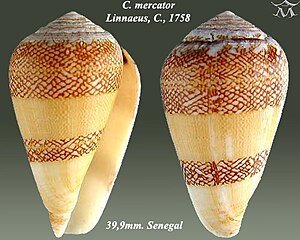Dealer cone
| Dealer cone | ||||||||||||
|---|---|---|---|---|---|---|---|---|---|---|---|---|

Housing from Conus mercator |
||||||||||||
| Systematics | ||||||||||||
|
||||||||||||
| Scientific name | ||||||||||||
| Conus mercator | ||||||||||||
| Linnaeus , 1758 |
The dealer cone or dealer-cone snail ( Conus Mercator ) is a snail from the family of cone snails (genus Conus ), which in the eastern Atlantic Ocean on the coast of West Africa is widespread.
features
Conus mercator carries a small to medium-sized, moderately heavy, slightly shiny snail shell , which in adult snails reaches 2 to 5.5 cm in length. The thread is low to medium high and has a blunt point, its outline is straight to concave. The circumference of the body is low, conical with back convex sides and a tapered to narrow base. The shoulder is rounded and convex at the top and does not stand out from the thread. The surface of the shell is yellowish or ash gray, often with indistinct, longitudinal chestnut brown lines and with a broad band at the shoulder and a narrower one in the middle, both made of a dense white-chestnut brown net pattern.
distribution and habitat
Conus mercator is widespread in the eastern Atlantic Ocean on the entire coast of West Africa from Senegal to Angola . It lives in the intertidal zone on sand or gravel surfaces.
Development cycle
Like all cone snails, Conus mercator is sexually separate and the male mates with the female with his penis . The female attaches about 5.4 to 7 mm high capsules to the substrate, in which there are about 14 to 60 eggs with a diameter of about 400 µm. In the capsule, the embryos go through the stage of Veliger larvae and hatch as finished crawling snails - similar to the Mediterranean cone, but in contrast to most other cone snail species.
Way of life
So far there are no publications about the diet and the range of prey of Conus mercator . According to the systematics of JK Tucker and MJ Tenorio (2009), Conus mercator belongs to the genus Lautoconus , which is a subgenus of Conus according to the revision by N. Puillandre, TF Duda, C. Meyer, BM Olivera and P. Bouchet (2015) . Other cone snails of this Atlantic sub-genus, namely the best-studied Mediterranean cone ( Conus ventricosus ), eat various poly- bristle species, which they poison by single or multiple pricking with their radula teeth and thus paralyze them before devouring them.
literature
- George Washington Tryon: Manual of Conchology, structural and systematic, with illustrations of the species , vol. VI; Academy of Natural Sciences, Philadelphia 1884. C [onus] mercator Linn., P. 55.
- Jerry G. Walls: Cone Shells: A Synopsis of the Living Conidae TFH Publications, Neptune (New Jersey) 1979. p. 710.
Web links
- Conus mercator Linnaeus, 1758 . Paul Kersten, The Cone Collector, 2018.
Individual evidence
- ^ J. Knudsen: Egg capsules and development of some marine prosobranchs from tropical west Africa. Atlantide Report: Scientific Results of the Danish Expedition to the Coasts of Tropical West Africa, 1945-1946, Volume 1, pp. 85-130, here p. 119. Danish Science Press, Copenhagen 1950.
- ↑ JK Tucker, MJ Tenorio (2009): Systematic Classification of Recent and Fossil Conoidean Gastropods. ConchBooks, Hankenheim 2009.
- ↑ N. Puillandre, TF Duda, C. Meyer, BM Olivera, P. Bouchet (2015): One, four or 100 genera? A new classification of the cone snails. Journal of Molluscan Studies 81, pp. 1-23.